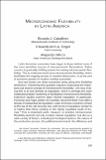Artículo
Microeconomic flexibility in Latin America
Fecha
2005Resumen
Latin American economies have begun to leave behind some of the most primitive sources of macroeconomic fluctuations. Policy concern is gradually shifting toward increasing microeconomic flexibility. This is a welcome trend since microeconomic flexibility, which facilitates the ongoing process of creative-destruction, is at the core of economic growth in modern market economies. But how poorly are these economies doing along this flexibility dimension? Answering this question requires measuring the important, but elusive concept of microeconomic flexibility. One way of doing this is to look directly at regulation, which is perhaps the main institutional factor hindering or facilitating microeconomic flexibility. Extensive studies examine labor market regulation, in particular. Heckman and Pagés (2000), for example, document that “even after a decade of substantial deregulation, Latin American countries remain at the top of the Job Security list, with levels of regulation similar to or higher than those existing in the highly regulated south of Europe.”
Colecciones
Descargar


